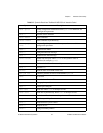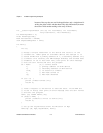
Chapter 7 NI-488.2 Programming Techniques
NI-488.2 User Manual for Windows 7-2 www.natinst.com
• EOS read method—If this is enabled,
ibrd
,
ibrda
, and
ibrdf
calls
are terminated when the EOS byte is detected on the GPIB, when the
GPIB EOI line is asserted, or when the specified count is reached. If
the EOS read method is disabled,
ibrd
,
ibrda
, and
ibrdf
calls
terminate only when the GPIB EOI line is asserted or the specified
count has been read.
You can use the
ibconfig
function to configure the software to indicate
whether the GPIB EOI line was asserted when the EOS byte was read in.
Use the
IbcEndBitIsNormal
option to configure the software to report
only the END bit in
ibsta
when the GPIB EOI line is asserted. By default,
END is reported in
ibsta
when either the EOS byte is read in or the EOI
line is asserted during a read.
High-Speed Data Transfers (HS488)
National Instruments has designed a high-speed data transfer protocol for
IEEE 488 called HS488. This protocol increases performance for GPIB
reads and writes up to 8 Mbytes/s, depending on your system.
HS488 is a superset of the IEEE 488 standard; thus, you can mix
IEEE 488.1, IEEE 488.2, and HS488 devices in the same system. If HS488
is enabled, the TNT4882C hardware implements high-speed transfers
automatically when communicating with HS488 instruments. If you
attempt to enable HS488 on a GPIB interface that does not have the
TNT4882C hardware, the ECAP error code is returned.
Enabling HS488
To enable HS488 for your GPIB interface, use the
ibconfig
function
(option
IbcHSCableLength
). The value passed to
ibconfig
should
specify the number of meters of cable in your GPIB configuration. If you
specify a cable length that is much smaller than what you actually use,
the transferred data could become corrupted. If you specify a cable length
longer than what you actually use, the data is transferred successfully,
but more slowly than if you specified the correct cable length.
In addition to using
ibconfig
to configure your GPIB interface for
HS488, the Controller-In-Charge must send out GPIB command bytes
(interface messages) to configure other devices for HS488 transfers.


















